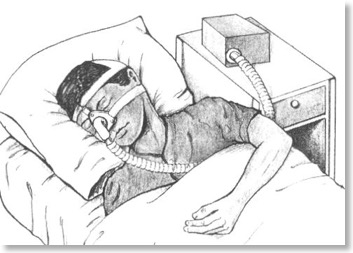Apnea Treatment
Treatment of OSA, Obstructive Sleep Apnea, usually reverses these symptoms and may help or prevent consequences such as high blood pressure. In many cases, the benefits of treatment are felt quickly after treatment begins.
What treatment will I be offered?
If you are diagnosed with OSA you may benefit from both general measures and specific treatments.
General Measures:
Normalize weight. Weight loss may help in the treatment of OSA. Significant weight loss (20% or more of body weight) may be an effective treatment in some individuals. Even partial weight loss - for instance, 20 pounds by a 200-pound man who should weigh 165 may improve breathing during sleep, making sleep more restful and lessening daytime sleepiness.
Avoid alcohol within four hours of bedtime. Alcohol depresses breathing and makes OSA episodes more frequent and severe. Alcohol also appears to trigger OSA in people who whould otherwise merely snore.
Avoid sleeping pills. Sleeping pills depress breathing, relax the muscles of the throat and generally make OSA worse. Exceptions may be necessary for people who are bothered by frequent awakenings that are not due to OSA episodes. Seek out a healthcare professional's advice if you use sleeping pills and have OSA or symptoms of OSA.
Take all drugs with care. Medications prescribed for headaches, anxiety, and other common problems can affect sleep and breathing.
Sleep lying on your side or stomach. Some people suffer from OSA only when lying on their back. Pillows placed behind the back or a tennis ball placed in a pocket sewn into the back of a pajama top will prevent sleeping on your back.
Medications to relieve congestion of the nose may be helpful in reducing snoring and the likelihood of OSA episodes. Nasal dilating devices, such as external elastic strips, can be used to open the nasal passageways and decrease snoring, although they usually will not adequately treat OSA.

Continuous Positive Airway Pressure
(CPAP):
In this highly effective therapy, a small mask is worn over the nose during sleep. Pressure from an air compressor forces air through the nasal passages and into the throat. This gentle pressure holds the throat open and allows normal sleep and breathing. Approximately 60 - 70% of patients who try CPAP find it a good solution to their breathing problem.
Oral appliances:
Some OSA patients are helped by devices that open the airway by bringing the jaw or tongue forward. The most common type is similar to a "bite plate" or "mouth guard". Patients with mild or moderate OSA may experience benefit by using such an oral appliance. Severe OSA usually does not respond well to this type of treatment, but may be worth trying if the patient cannot tolerate CPAP. Excessive salivation, jaw pain, and loosening of teeth are some complications that can be encountered when using these oral appliances.
Inspire:
Inspire is an alternative therapy for patients that are intolerant of or unable to use CPAP. Inspire works inside your body while you sleep. It’s a small device placed during a same-day, outpatient procedure.
When you’re ready for bed, simply click the remote to turn Inspire on. While you sleep, Inspire opens your airway, allowing you to breathe normally and sleep peacefully.
There are additional qualifications that must be met for insurance coverage in order to get the Inspire device. You must be diagnosed with moderate to severe OSA, CPAP failure, or inability to tolerate CPAP, physical examination including height, weight and sleep history, and airway exam showing that your tongue will open for your airway. Insurance carrier qualifications can vary.
Surgery:
Physical problems that interfere with breathing during sleep can sometimes be corrected surgically. These problems include: enlarged tonsils or adenoids (common in children), nasal polyps or other growths, a deviated septum, and unusually formed jaw or soft palate. Nasal operations used to remove blockages in the nose as the only treatment of snoring and OSA are usually not effective. However, nasal surgery may be one part of an overall plan for surgical treatment of OSA.
Using a technique known as the Uvulopaoatopharyngoplasy (UPPP), a surgeon removes excess tissue at the back of the throat that may be blocking the airway during sleep. Studies show that UPPP benefits about half of those people who undergo the surgery. Studies are underway to identify the patients most likely to be helped by this procedure.
